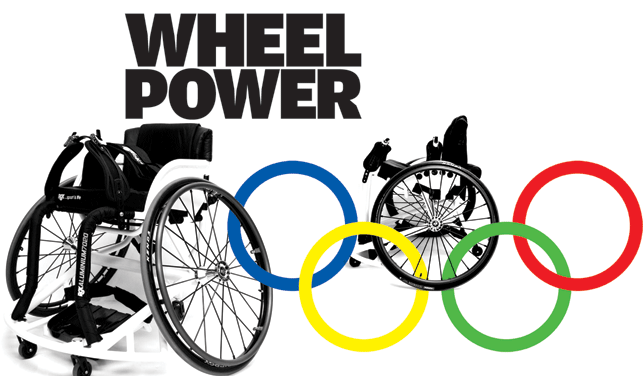
As you approach the entrance of RGK’s head office based in an industrial unit in Burntwood, Staffordshire, the electric doors open wide and you are greeted with a low table featuring a sign-in book.
Immediately a man comes towards you in his wheelchair and it all makes sense. In fact, the co-founders of RGK and all its sales staff are wheelchair users. And it’s on this 3,000 square foot site where the company and its 50 strong staff designs, engineers as well as manufactures all its wheelchairs, which are all made to order.
Each of the 12 chairs in the product range, whether it’s the Hi-Lite daily use chair, MaxPlay kids chair, MRX off-road chair, Grand Slam tennis chair or its very latest Elite basketball chair, which Team GB will be using in the London Paralympic Games, is made-to-measure. “In the drawing office we probably do 3,000 different products every year,” says Michael Sheen, the design and engineering manager at RGK.
“We have eight to ten projects going on at any one time. I tend to find that I’ll start one and then something else will come along and take priority. For example, we have just completed an aluminium tennis chair for a dealer in Holland.
“There is a big market for it so we managed to turn it around in two weeks – a week spent rebuilding it in CAD and then a week building it in the factory.”
Sheen joined RGK in September 2009. He was specifically employed to help bring new products to market but also to streamline the company’s design and development processes. He brought 3D CAD into the business in the form of SolidWorks. At the time, production drawings were created using the 2D CAD system ParaCAD. Although ParaCAD has not completely left, the plan is to eventually bring all the templates over to SolidWorks.
Essentially, each chair in the range has its own template that the user dimensions and specifications are plugged into to create a chair bespoke to that individual. So, it is not a case of ‘one chair fits all’ as the seat of each chair is different depending on the user’s disability – whether that be a foot injury or amputee all the way through to someone who has cerebral palsy or is a paraplegic.
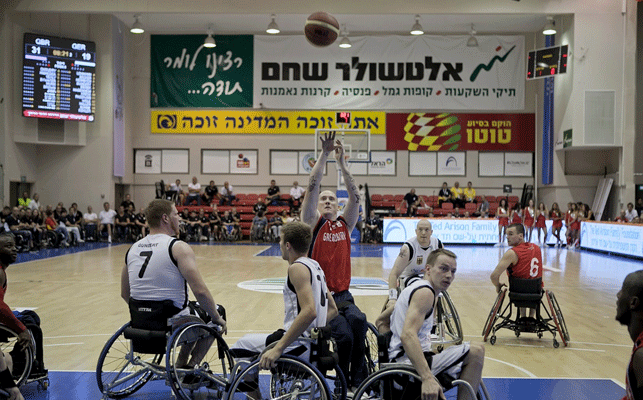
The ‘Bulldogs’, Great Britain’s Paralympic wheelchair basketball team, in action
“It has to be a versatile design. If you have a low frame, high frame or whether it’s wide or short it all has to fit into the same template. So the design doesn’t change even if we get an unusual seat bucket shape,” explains Sheen.
“This is why the parametric tools within SolidWorks have been so beneficial in helping us to streamline our process and make it more robust. This simply reduces the amount of CAD modelling we need to do per chair and makes it more of a data input exercise. About 50 per cent of the chairs fall into our standard template, but the others require tweaks and changes depending on the requirements from the customer. We see the parametric tool as the starting point to our design process, and it works superbly.”
Made to measure
The process begins with the sales representative measuring the user to create a detailed specification, which is then handed over to the design engineers for them to create the 3D models. Once the model is complete, 1:1 drawings are printed using the in-house HP Designjet A0 printer. “The 3D models take longer to do than the 2D but it means that you give a lot more information to the guys on the shop floor, which ultimately results in a better and more consistent end product.”
These 1:1 drawings are inspected and then handed over to one of the highly skilled frame builders, some of whom have been at RGK for over ten years. There are eight in total and each has their own jig to build as much of the frame as possible whether it be aluminium, titanium or steel.
Simultaneously, the in-house seamstresses will be working on the custom upholstery. The chairs are also powder coated in-house and then assembled with some of the components bought in including the tyres and wheels.
“It’s great to actually see your design being manufactured, and when it’s happening on the other side of the office door, there is always a real excitement in the design office. It’s rare to find this these days and it’s a privilege to have this capability,” comments Sheen.
As well as being able to view the latest range in the printed and online brochures, customers are encouraged to actually come to the showroom in the Burntwood factory to try out the wheelchairs for themselves and talk to a customer advisor. One of the wheelchairs that has a very prominent position in the showroom recently is the Elite basketball wheelchair.
Basketball wheelchairs are RGK’s biggest business and over the past year and a half the focus in this area has been on the Elite, which Team GB will be using in the Paralympic Games. Other international players have also signed up for, what RGK claims as, its lightest and most responsive basketball wheelchair ever.

The Elite started out life as a 3D drawing
before more features are added in, such as the wheels, to make the finished article
On a roll
For those unfamiliar with the game, wheelchair basketball is considered to be one of the major disabled sports. Its roots go back to the 1940s when Sir Ludwig Guttmann adapted existing wheelchairs so that injured war veterans could play sport as part of a rehabilitation programme at Stoke Mandeville Hospital in Aylesbury, UK.
Initially called wheelchair netball it soon grew in popularity. At the first Paralympic Games, which Guttmann founded in Rome in 1960, wheelchair basketball was named an official sport.
Played by two teams of five, wheelchair basketball retains most major rules and scoring of basketball with the same size court and basket height. Like basketball, players must not ‘travel’ with the ball and are required to throw or bounce it after every two pushes of their wheels. Matches consist of four quarters of ten minutes each.
However, there is a classification system in wheelchair basketball. Minimally disabled athletes are classified as 4.5 whereas an athlete such as a paraplegic with a complete injury below the chest would be classified as 1.0. The total number of points allowed on court at any one time is 14.0.
“The athlete’s disability will determine what type of chair will make their game the best it can be. Usually an amputee or someone with a foot disability will have a high chair whereas a very deep bucket would be used by someone who has a spinal injury,” explains Sheen.
“Also, no matter what sort of seat they have they strap themselves in really tightly as they often fall out the chairs but then just push themselves straight back up again. Their upper body strength is incredible.”
Light work
Sheen designed the Elite from scratch initially creating concept sketches that looked at how the wheelchair could be made to be as light and stiff as possible.
“Although it’s all about weight and stiffness you can’t lose track that it’s a wheelchair so the frame will always look sort of similar,” he says. “I didn’t spend too much time messing around with wacky frame designs because they are just not going to work. It’s all about performance and we have fine tuned all of the areas to maximise the Elite on court.”
Sheen explains that in order to make the frame as strong as possible he often had to play off certain things against each other such as a small weight increase for a bigger tube. “I did a lot of stress analysis in SolidWorks looking at what was the strongest frame and where the stress was going through. We also looked at where the impacts would come from and how to absorb the energy coming from those areas, much like a car bumper. The difference to a car is that this chair has to withstand multiple crashes, so the form followed that really.”
There are a number of known features in a wheelchair design such as the wheel camber. Unlike wheelchairs used for daily use, sports wheelchairs have wheels that are angled so the top of the wheels are brought closer together. Increasing the camber in this way adds lateral stability and also allows for easier sideways movements and turning on the spot.
The average wheel camber of the Elite is 18 degrees and, unlike the chair’s predecessors, Sheen decided to add in an oversized straight camber-bar that joins the two wheel axles in order to keep the lightweight frame rigid and solid.
Likened to bumper cars, wheelchair basketball is unofficially a contact sport and really tests wheelchairs to the limit. The area that takes the most abuse is the front wing. With the new position of the down tubes, instead of the force going through the front castor pots, it goes up to this bar, which is the strongest part of the chair.
“Our biggest failure on previous sports chairs are the braces on the front wing so changing how the force goes through the frame has made a massive difference,” says Sheen.
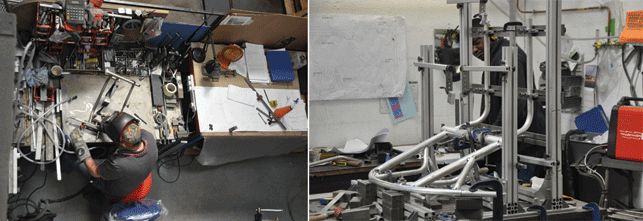
A frame builder working in RGK’s in-house factory, and a jig with a frame being built
Material selection
RGK also elected to use aluminium 7020 over titanium for the Elite. “The strength you get from titanium and aluminium is almost identical but in aluminium in order to get the same strength you need to have a bigger tube and this means a bigger weld resulting in better reliability in terms of breakages.
“So, although the two materials have the same strength to weight ratio, the aluminium frame has a bigger tube which increases the stiffness. This is a great advantage,” he says.
“When you sit down in a titanium chair the whole chair flexes just a little bit, which results in lost energy on the court, but as a day chair it’s very popular as it absorbs the bumps. Aluminium is so rigid, all your force goes through it meaning that the minimal amount of energy is lost during pushing and manoeuvring, which makes the chair faster and more responsive.”
In June 2011 the first prototype of the Elite was given to Simon Munn, a Great Britain basketball player for whom London 2012 will be his sixth Paralympic Games. Munn is a left leg amputee. “He loved it and that was great for us because he is such an important part of the squad.
“We wanted him in it for a year to test the material, the front wing and everything we weren’t sure of because it is a new design.”
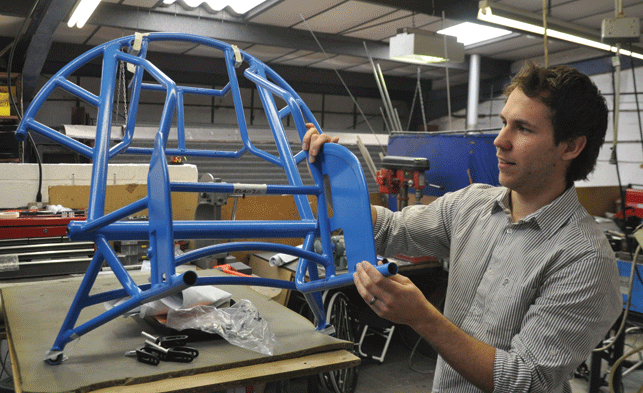
Michael Sheen demonstrating RGK’s bespoke paint job
Full process
Munn is about to return that prototype for his updated version, which is virtually the same apart from a bit of tweaking due to personal preference.
“RGK’s products had never been through the typical design process and this is the first product that we’ve gone through the right process by getting it out there, getting people in it, testing it, prototyping it and doing some trial runs. It’s been great,” says Sheen.
So far, RGK has built 110 separate designs of the Elite, many of which are going to athletes participating in London 2012. Sheen is hoping to see ‘The Bulldogs’, the nickname for Great Britain’s mens team, playing in the basketball arena in London’s Olympic Park.
“The chairs are such an important part of the player and it’s vital they feel comfortable and confident, which can sometimes be the difference between winning and losing,” he says. “Getting a GB Elite on the podium would be a dream come true and we’re confident the Elite can make a difference. But it’s all up to the GB men and women now!”
rgklife.com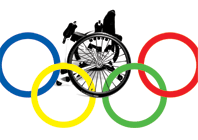
Britain’s Bulldogs will be going into battle in RGK’s bespoke basketball wheelchairs
Default






